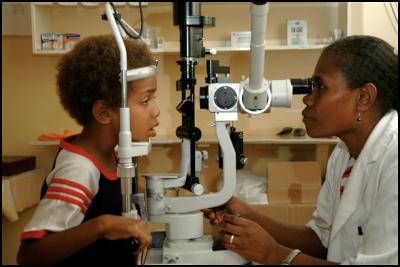Ratification of UN Convention welcomed
The Fred Hollows Foundation NZ welcomes ratification of UN Convention on the Rights of Persons with Disabilities

Click to enlarge
A young boy has his eye’s screened in Vanuatu. Over 90% of the world’s blind and visually impaired people live in developing countries and in some countries up to 60% of children die within a year of becoming blind. Blind and visually impaired children are more likely to miss out on schooling, adults face economic hardship, and are at far greater risk of entering into poverty as a result of these disabilities. With access to eye care and surgery, over three quarters of blind and visually impaired people can have their sight restored.
For Immediate Release
12th May 2008 – The Fred Hollows Foundation NZ welcomes ratification of UN Convention on the Rights of Persons with Disabilities
The Fred Hollows Foundation NZ welcomes the ratification of the UN Convention on the Rights of Persons with Disabilities that came to force on 3 May 2008. The ratification guarantees the rights of 650 million people worldwide who have disabilities.
The Convention, the first international human rights treaty of the 21st century, will be a powerful tool in removing the many barriers to disabled people’s participation in national and international affairs. Importantly, it will promote the rights of people with disabilities to health care, education and employment opportunities in their own countries.
It is estimated that 80% of people with disabilities live in the developing world. Blind and visually impaired people represent a significant proportion of this number, with a current global estimate of more than 161 million.
The Fred Hollows Foundation NZ’s Pacific Program Manager, Anna Palagyi, says the Convention is a milestone in the history of human rights and welcomes the influential role it will play in the treatment of people with vision problems in the developing world, including the countries of the Pacific region:
“The Fred Hollows Foundation NZ advocates for equal access to health care, and eye care and education for people who are blind and visually impaired. The Convention is a positive step in recognizing the rights of visually impaired persons and supporting their inclusion in society.”
Over 90% of the world’s blind and visually impaired people live in developing countries and in some countries up to 60% of children die within a year of becoming blind. Blind and visually impaired children are more likely to miss out on schooling, adults face economic hardship, and are at far greater risk of entering into poverty as a result of these disabilities. With access to eye care and surgery, over three quarters of blind and visually impaired people can have their sight restored.
“The Convention, and its recognition for the right to health care for people with disabilities, is a crucial step in ensuring social justice prevails. People who can have their visual disability reduced and their vision restored, have the right to receive this treatment. The Fred Hollows Foundation NZ welcomes the UN’s recognition of these rights,” said Ms Palagyi.
ENDS
NOTES TO EDITORS:
1. The UN Convention on the Rights of Persons with Disabilities and its Protocol came into force 3rd May 2008, only eighteen months after its adoption by Member States on 13th December 2006.
2. The Convention recognises the rights of people with disabilities to education, health, work, freedom of movement, freedom from exploitation and equal recognition before the law. It also recognises the need for persons with disabilities to have access to public transport, buildings and other facilities and recognises their capacity to make decisions for themselves.
3. New Zealand has been widely recognised for its leadership in ratifying the Convention and was awarded this year’s Franklin Delano Roosevelt International Disabilities Award on 6th May 2008 by Secretary-General Ban Ki-moon for its efforts to improve the lives of those living with disabilities.
4. There are 80, 000
blind in the Pacific region and a further 240,000 suffer
severe visual
impairment.
ENDS


 Air New Zealand: Raw Thrills - Air New Zealand's Most Popular Inflight Entertainment Revealed
Air New Zealand: Raw Thrills - Air New Zealand's Most Popular Inflight Entertainment Revealed Hustle Management: Celebrating 50 Years Of Music, Now And Then, With Mark Williams
Hustle Management: Celebrating 50 Years Of Music, Now And Then, With Mark Williams Massey University: Birdnapped Cockatoo Wins Quote Of The Year
Massey University: Birdnapped Cockatoo Wins Quote Of The Year LAWA: “Know Before You Go” – Check Summer Swimming Water Quality Online
LAWA: “Know Before You Go” – Check Summer Swimming Water Quality Online Official Aotearoa Music Charts: 2024 End Of Year Charts Have Been Published
Official Aotearoa Music Charts: 2024 End Of Year Charts Have Been Published Nielsen Book NZ: Nielsen BookData Announces 'In Too Deep' Is The Official New Zealand Number 1 Christmas Bestseller
Nielsen Book NZ: Nielsen BookData Announces 'In Too Deep' Is The Official New Zealand Number 1 Christmas Bestseller